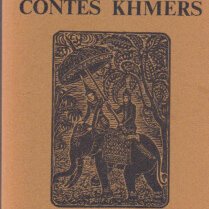Guillaume-Henri [or Guillaume-Henry or Guillaume] Monod (1 January 1875, London, UK — 30 March 1946, Aix en Provence, France) was a French civil administrator, geologist and writer who spent nearly 30 years in Cambodia, collecting Cambodian folktales and authoring essays on Cambodian language and culture.
After studying siences in Paris, Monod went to Southeast Asia in 1895, becoming adjunct-geologist of the Service géologique de l’Indochine (SGI) in 1898 — where he befriended colleague and archaeologist Henry Mansuy (18 Feb. 1857 — 21 Oct. 1937 -, and was later appointed vice-director of the SGI. He explored Yunan to draw a map of geological resources of the region. He came back to Europe in order to serve in the French army (43d infantry regiment) during WWI, was wounded in Sarrebruck and received the Légion d’Honneur in 1915 (Chevalier in 1929).
In 1909, he enlisted to Louis Finot’s initiation course to Sanskrit at Ecole Pratique des Hautes Etudes (EPHE), Paris. Back to Cambodia, he traveled to remote parts of the Kingdom, in particular the region of Pursat, for his work but often accompanied by his wife, Sophie Marie Jeanne Hübler (27 December 1878, Bordeaux — 4 March 1954, Aix-en-Provence) — they had married in 1904 -, noting down legends and folktales from oral traditions. His most ambitious synthesis on Cambodian culture, Le Cambodgien (1931), was found “somewhat superficial” by George Coedès, who listed several linguistic errors and factual omissions [G. Coedès, ‘G. H. Monod : Le Cambodgien’, BEFEO 31, 1931: 232 – 233.]
In Phnom Penh, Guillaume Monod showed his notes to Princess Yukantor Malika (1872 — 18 March 1951), the highly educated royal princess who worked to promote Cambodian girls through the Malika School. A long-lasting frienship was established with the family of Prince Norodom Yukanthor Aruna (1860 — 27 June 1934), who had been banished to Bangkok by the French authorities. He exchanged a correspondence with Malika’s and Yukhantor’s son, the artist and writer Areno, whom he often saw in Paris, and personally interceded when the French administration attempted to deprive the family of Prince Yukanthor’s royal pension. He dedicated his 1931 book to “Madévi”, pet name of Sara Mahadévi Andjaline Somali Iukanthor, the daughter of Areno and harpist Raymonde Riou, and his 1943 publication to one of Princess Malika’s daughters, Princess Yukhantor Pingpeang, who had helped him in his research on Cambodian folklore [1].
Monod retired from civil service (1st class administrator) on 1st October 1925, definitevey leaving Cambodia to spend his time between Paris and southern France.
[1] Grégory Mikaelian has hypothesized that Guillaume-Henry Monod might have used the pseudonym “G. Henry” in a 1925 article (G. Henry, ‘Le bon roi Sisowath’, La Revue universelle, 1 Sept. 1925, p. 585 – 593) claiming that Areno Iukanthor, “extremely popular in Cambodia but pursued by the Minister of the Palace’s [Oknha Veang Thiounn] hatred” would be the perfect successor to King Sisowath after his death. [G. Mikaelian, ‘La bohème parisienne d’Areno Iukanthor (1919−1938): du prince de l’imitation à l’initation du prince’, Bulletin de l’AEFEK (BAEFEK) 24, Dec. 2021, p 17].
Publications
- “L’orthographie dite “Quốc Ngữ” appliquée au Cambodgien,” Revue indochinoise, 2nd sem. 1907: 1172 – 1177.
- Notice sur la région de Pursat, 1911, Phnom Penh.
- Légendes cambodgiennes que m’a racontées le gouverneur Khieu, 1922, Paris, 148 p. | repr. as Contes khmer, Cedoreck, 2004; repr. as La fondation d’Angkor et autres légendes cambodgiennes, 2016, Lausanne, Olizane, ISBN 978−2−88086−445−3 [illust. by Amélie Strobino] | ENG Women’s Wiles: Cambodian Legends Collected by Guillaume Henri Monod, tr. Solang Uk, ed. Kent Davis, DatASIA, 2013, 231 p.
- Quelques mots sur les Cambodgiens, Paris, offprint of La Revue du Pacifique, 1923, 36p.
- [introduction to] Ruines d’Angkor, Saigon, Edition Photo Nadal, Saigon, nd [circa1925].
- Le Cambodgien, Paris, Ed. Larose, 1931, 96 p.
- Contes khmers, Mouans, Editions Chitra, 1943 [with illustrations by Andrée Karpelès].

